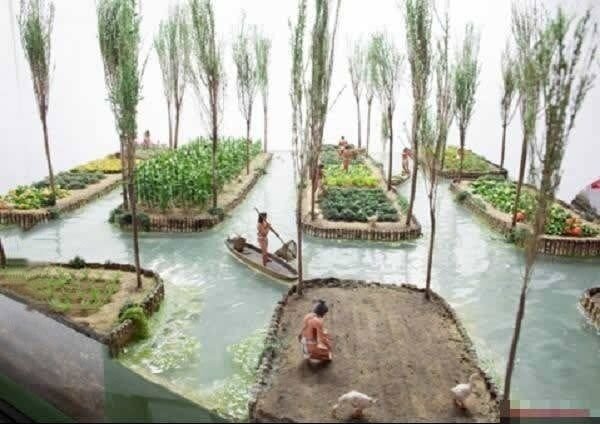The Ancient Chinampas: 5 Fascinating Facts

The ancient Chinampas, a unique and innovative agricultural system developed by the Aztecs, continue to captivate historians, archaeologists, and enthusiasts alike. These floating gardens, a masterpiece of ancient engineering, offer a glimpse into the ingenuity and sustainability of Aztec civilization. Here, we delve into five fascinating facts about the Chinampas, uncovering their historical significance and impact on the Aztec world.
The Origins and Purpose of Chinampas

Chinampas, a word derived from the Nahuatl language, refers to the intricate system of agricultural beds created by the Aztecs in the shallow lakes surrounding their capital, Tenochtitlan. This ancient practice, dating back to the 10th century, revolutionized food production in the region. The Aztecs, facing the challenges of feeding a growing population in a lake-dominated landscape, innovated with the Chinampa system, which involved constructing raised beds or “islands” in the lakes, transforming them into fertile agricultural plots.
These floating gardens served a dual purpose. Firstly, they provided a sustainable food source, allowing the Aztecs to cultivate a variety of crops, including maize, beans, squash, and chili peppers. Secondly, Chinampas played a crucial role in stabilizing the soft, marshy ground, preventing erosion, and thus safeguarding the delicate lake ecosystems.
Construction and Design

The construction of Chinampas was a labor-intensive process, involving the use of local materials and a deep understanding of the lake environment. Aztecs built these floating gardens by driving long poles into the lake bed, creating a rectangular frame. They then wove reeds and branches horizontally between the poles, forming a strong structure. Over time, this framework was filled with layers of mud, weeds, and decaying vegetation, creating a rich, fertile soil ideal for crop growth.
The design of Chinampas was ingeniously tailored to the lake environment. Each garden was constructed parallel to the lake's shore, with narrow canals in between, facilitating water circulation and providing access for canoes. This layout maximized the use of space and allowed for efficient transportation of crops and materials.
Sustainable Agriculture
Chinampas exemplified sustainable agricultural practices long before the concept became a global priority. The use of organic matter and natural materials in construction minimized environmental impact. Moreover, the raised beds, with their unique soil composition, provided excellent drainage, reducing the risk of waterlogging and allowing for year-round cultivation. This system also encouraged biodiversity, attracting a variety of aquatic plants and animals, which further enriched the ecosystem.
The Aztecs' agricultural knowledge extended beyond Chinampas. They employed various techniques, such as crop rotation, companion planting, and the use of natural fertilizers, ensuring the long-term fertility and productivity of their land.
Productivity and Impact on Aztec Society
The productivity of Chinampas was remarkable. Despite occupying only a small fraction of the lake’s surface, these floating gardens yielded an abundance of food. The rich, nutrient-dense soil and favorable microclimate resulted in high crop yields, contributing significantly to the Aztec’s food security and surplus production. This surplus was traded or used to feed the growing population of Tenochtitlan, supporting the city’s economic and social development.
The success of Chinampas had far-reaching effects on Aztec society. It fostered a sense of community and collaboration, as the construction and maintenance of these gardens required collective effort. Additionally, the reliable food supply enabled the Aztecs to focus on other aspects of civilization, including art, architecture, and cultural advancements.
Legacy and Modern Applications
The legacy of Chinampas extends beyond the fall of the Aztec Empire. This ancient agricultural system has left a lasting impact on modern farming practices. Today, the principles of Chinampas are being revived and adapted in various parts of the world, particularly in regions facing similar environmental challenges. Modern interpretations of Chinampas, known as “floating gardens” or “aquaponic systems,” are being used to address issues of food security and sustainable agriculture.
In Mexico, where the tradition of Chinampas originated, efforts are underway to preserve and restore these ancient gardens. Organizations and communities are working to revive this traditional practice, not only for its historical value but also for its potential to contribute to sustainable food production and ecological conservation.
| Fact | Details |
|---|---|
| Number of Chinampas in Tenochtitlan | Estimates suggest there were over 9,000 Chinampas surrounding the Aztec capital, covering an extensive area. |
| Diversity of Crops | Chinampas supported a wide variety of crops, including amaranth, tomatoes, avocados, and even cotton, contributing to a diverse and nutritious diet. |
| Social Significance | The construction and maintenance of Chinampas involved the entire community, fostering a sense of collective responsibility and shared prosperity. |

How did Chinampas impact the environment of Tenochtitlan’s lakes?
+Chinampas had a stabilizing effect on the lake environment. By preventing erosion and promoting the growth of aquatic plants, they helped maintain the ecological balance of the lakes, providing habitat for various species.
Are there any surviving examples of Chinampas today?
+Yes, while many Chinampas have been lost over time, efforts to preserve and restore them are ongoing. Xochimilco, a borough in Mexico City, is known for its surviving Chinampas, offering a glimpse into this ancient agricultural practice.
How did the Aztecs manage pests and diseases in Chinampas?
+The Aztecs employed various natural methods to control pests and diseases. These included crop rotation, the use of certain plants as natural pesticides, and the practice of attracting beneficial insects and birds to their gardens.


